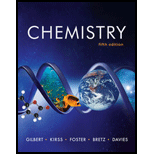
Concept explainers
(a)
Interpretation: Two different images showing different arrangement of particles is given. The class of matter (an element, a compound, a homogenous mixture, or a heterogeneous mixture) and the physical state in the given images is to be stated.
Concept introduction: The space between the particles of solids is very less, so they just vibrate at their own place, while the specie between the particles of liquid is more as compared to solids. The space between particles of gas is very large so they can easily move and collide with each other and with the walls of the container. Large space between the gaseous particles makes them highly compressible in nature.
When the atoms belonging to different elements are chemically combined in a fixed ratio then it leads to the formation of a compound while when the atoms of same type are combined together then it leads to the formation of an element.
The homogeneous mixture consists of same uniform composition and appearance throughout the mixture while the heterogeneous mixture has non-uniform composition throughout the mixture.
To determine: The class of matter (an element, a compound, a homogenous mixture, or a heterogeneous mixture) and the physical state in the given image.
(b)
To determine: The class of matter (an element, a compound, a homogenous mixture, or a heterogeneous mixture) and the physical state in the given image.
Want to see the full answer?
Check out a sample textbook solution
Chapter 1 Solutions
Smartwork5 Printed Access Card for Use with Chemistry: The Science in Context 5th Edition (SmartWork Access Printed Access Card)
 ChemistryChemistryISBN:9781305957404Author:Steven S. Zumdahl, Susan A. Zumdahl, Donald J. DeCostePublisher:Cengage Learning
ChemistryChemistryISBN:9781305957404Author:Steven S. Zumdahl, Susan A. Zumdahl, Donald J. DeCostePublisher:Cengage Learning ChemistryChemistryISBN:9781259911156Author:Raymond Chang Dr., Jason Overby ProfessorPublisher:McGraw-Hill Education
ChemistryChemistryISBN:9781259911156Author:Raymond Chang Dr., Jason Overby ProfessorPublisher:McGraw-Hill Education Principles of Instrumental AnalysisChemistryISBN:9781305577213Author:Douglas A. Skoog, F. James Holler, Stanley R. CrouchPublisher:Cengage Learning
Principles of Instrumental AnalysisChemistryISBN:9781305577213Author:Douglas A. Skoog, F. James Holler, Stanley R. CrouchPublisher:Cengage Learning Organic ChemistryChemistryISBN:9780078021558Author:Janice Gorzynski Smith Dr.Publisher:McGraw-Hill Education
Organic ChemistryChemistryISBN:9780078021558Author:Janice Gorzynski Smith Dr.Publisher:McGraw-Hill Education Chemistry: Principles and ReactionsChemistryISBN:9781305079373Author:William L. Masterton, Cecile N. HurleyPublisher:Cengage Learning
Chemistry: Principles and ReactionsChemistryISBN:9781305079373Author:William L. Masterton, Cecile N. HurleyPublisher:Cengage Learning Elementary Principles of Chemical Processes, Bind...ChemistryISBN:9781118431221Author:Richard M. Felder, Ronald W. Rousseau, Lisa G. BullardPublisher:WILEY
Elementary Principles of Chemical Processes, Bind...ChemistryISBN:9781118431221Author:Richard M. Felder, Ronald W. Rousseau, Lisa G. BullardPublisher:WILEY





